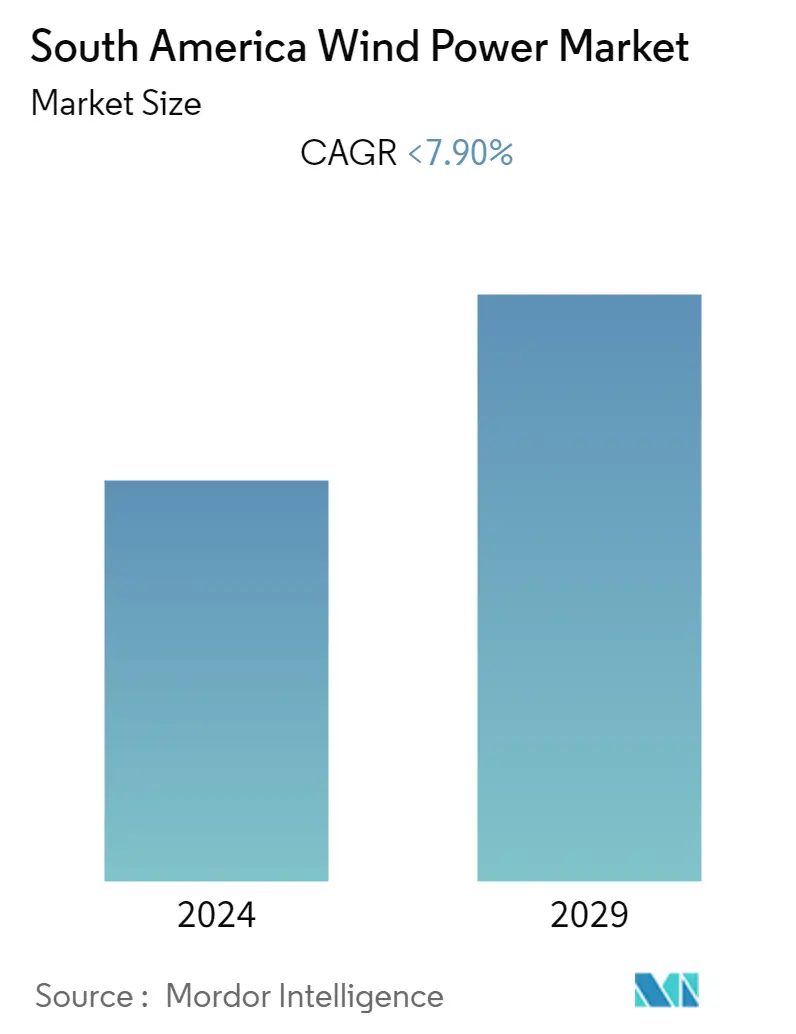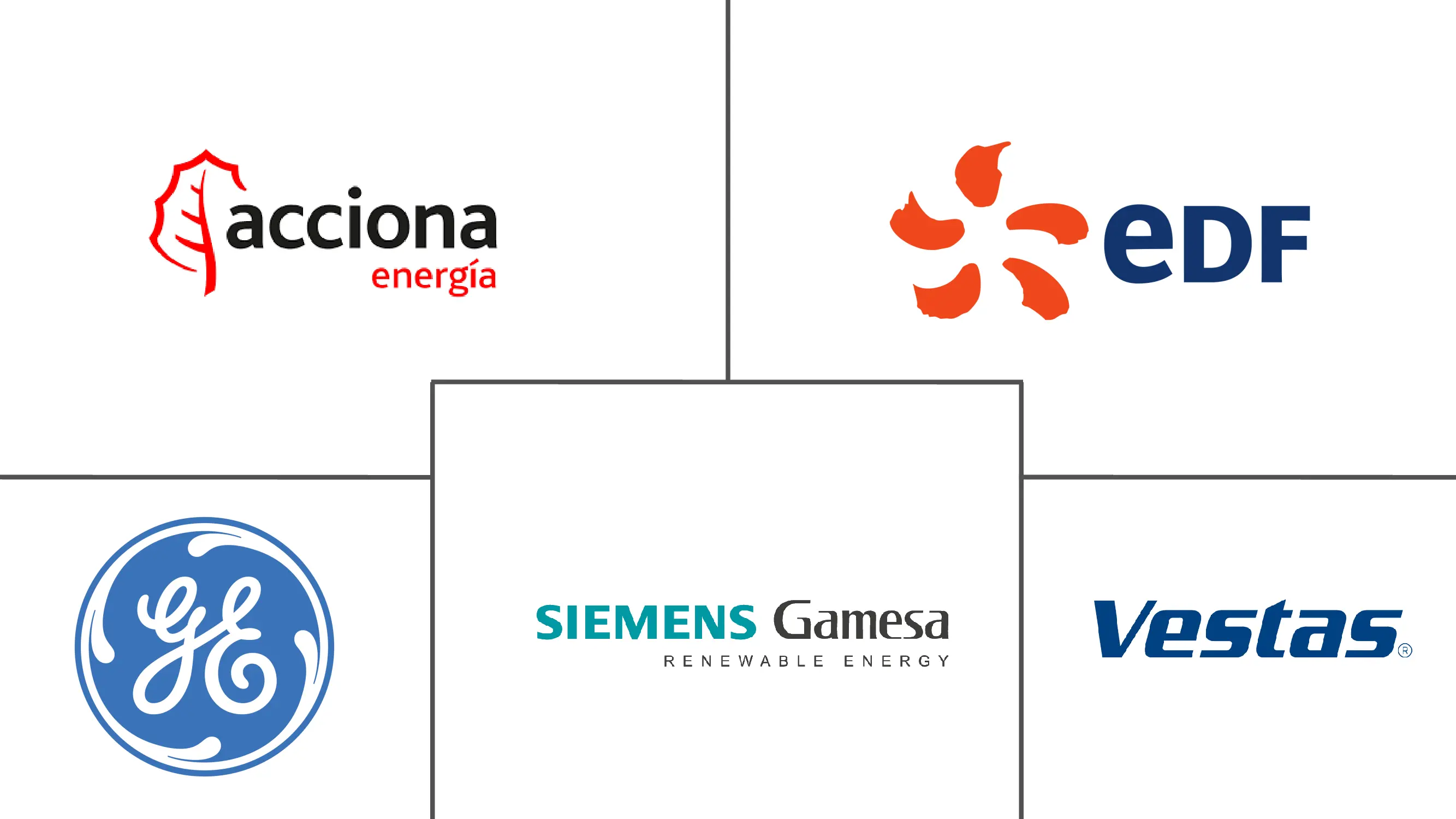Market Size of South America Wind Power Industry

| Study Period | 2021 - 2029 |
| Base Year For Estimation | 2023 |
| Forecast Data Period | 2024 - 2029 |
| Historical Data Period | 2021 - 2022 |
| CAGR | < 7.90 % |
| Market Concentration | Low |
Major Players
*Disclaimer: Major Players sorted in no particular order |
South America Wind Power Market Analysis
The South America Wind Power Market is projected to register a CAGR of over 7.9% during the forecast period.
COVID-19 moderately impacted the market in 2020. Currently, the market is likely to reach pre-pandemic levels.
- Over the medium term, major factors attributing to the growth include favorable government policies, the increasing investment in wind power projects, and the reduced cost of wind energy, which led to increased adoption of wind energy, thereby positively contributing to the demand for wind energy.
- On the other hand, the increasing adoption of alternate energy sources, such as gas-based power and solar power, is likely to hinder the market growth.
- Nevertheless, the technological advancements in efficiency and decrease in the production cost of offshore wind turbines are expected to create ample opportunity for the market players in South America.
- In South America, Brazil had the highest installed capacity in 2021 and is expected to be the largest market during the forecast period, bolstered by constant growth in onshore wind power additions and upcoming offshore wind power projects.
South America Wind Power Industry Segmentation
The wind produces electricity by converting the kinetic energy of air in motion into electricity. By rotating the rotor blades, wind transforms kinetic energy into rotational energy. The rotational energy is transferred to the generator through a shaft, generating electrical power.
South America wind power market is segmented by location of deployment. By location of deployment, the market is segmented into onshore and offshore. The report also covers the market size and forecasts for the wind power market across the countries in the region. For each segment, the market sizing and forecasts have been done based on installed capacity (GW).
| Location | |
| Onshore | |
| Offshore |
| Geography | |
| Brazil | |
| Chile | |
| Argentina | |
| Rest of South America |
South America Wind Power Market Size Summary
The South America wind power market is poised for significant growth, driven by favorable government policies, increased investments, and the declining cost of wind energy. The region, particularly Brazil, is experiencing a surge in onshore wind power installations, with Brazil leading in installed capacity. The technological advancements in wind turbine efficiency and the reduction in production costs are further bolstering the market's expansion. Despite the competition from alternative energy sources like gas-based power and solar energy, the wind power sector is expected to thrive, supported by strategic government initiatives and commitments to renewable energy targets. Countries like Chile and Colombia are making substantial strides towards renewable energy adoption, with ambitious plans to phase out coal and increase wind energy capacity.
Brazil stands out as a key player in the South American wind power market, with a robust pipeline of projects and supportive government frameworks facilitating offshore wind development. The country's energy development plans and the recent issuance of decrees for offshore wind projects underscore its commitment to expanding wind energy capacity. Additionally, international investments and partnerships, such as those by Statkraft and Acciona Energía, are further enhancing the market's growth prospects. The collective efforts in Brazil, Chile, Colombia, and Argentina are expected to drive the region's wind power market, making it a significant contributor to the global renewable energy landscape during the forecast period.
South America Wind Power Market Size - Table of Contents
-
1. MARKET OVERVIEW
-
1.1 Introduction
-
1.2 Wind Power Installed Capacity and Forecast in GW, until 2027
-
1.3 Recent Trends and Developments
-
1.4 Government Policies and Regulations
-
1.5 Market Dynamics
-
1.5.1 Drivers
-
1.5.2 Restraints
-
-
1.6 Supply Chain Analysis
-
1.7 Porter's Five Forces Analysis
-
1.7.1 Bargaining Power of Suppliers
-
1.7.2 Bargaining Power of Consumers
-
1.7.3 Threat of New Entrants
-
1.7.4 Threat of Substitutes Products and Services
-
1.7.5 Intensity of Competitive Rivalry
-
-
-
2. MARKET SEGMENTATION
-
2.1 Location
-
2.1.1 Onshore
-
2.1.2 Offshore
-
-
2.2 Geography
-
2.2.1 Brazil
-
2.2.2 Chile
-
2.2.3 Argentina
-
2.2.4 Rest of South America
-
-
South America Wind Power Market Size FAQs
What is the current South America Wind Power Market size?
The South America Wind Power Market is projected to register a CAGR of less than 7.90% during the forecast period (2024-2029)
Who are the key players in South America Wind Power Market?
Acciona Energia SA, EDF SA, General Electric Company, Siemens Gamesa Renewable Energy and Vestas Wind Systems AS are the major companies operating in the South America Wind Power Market.

